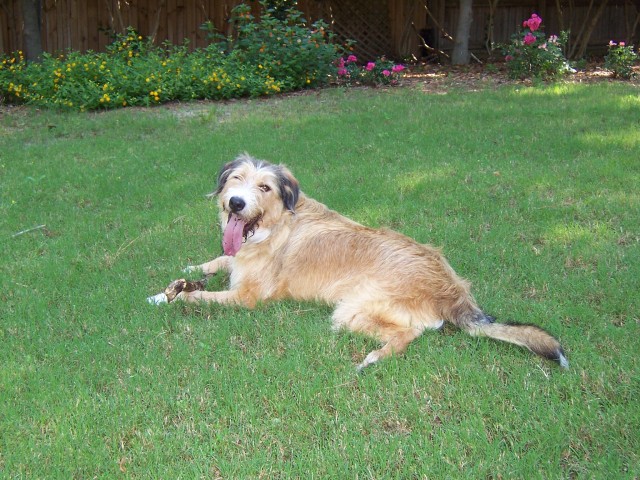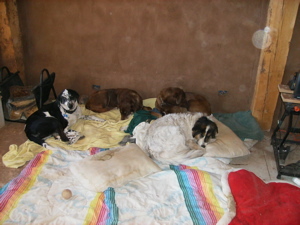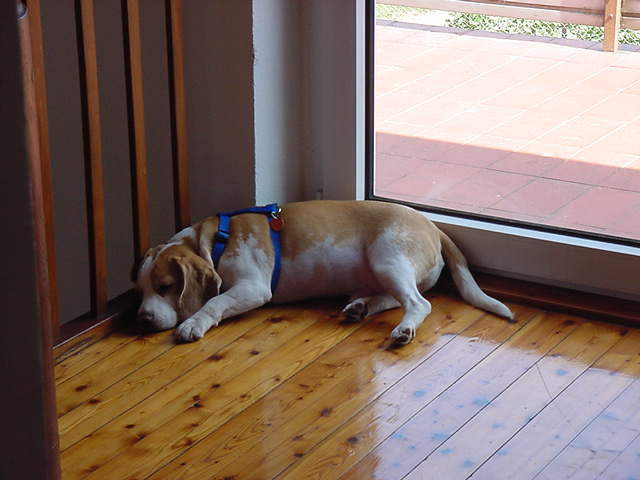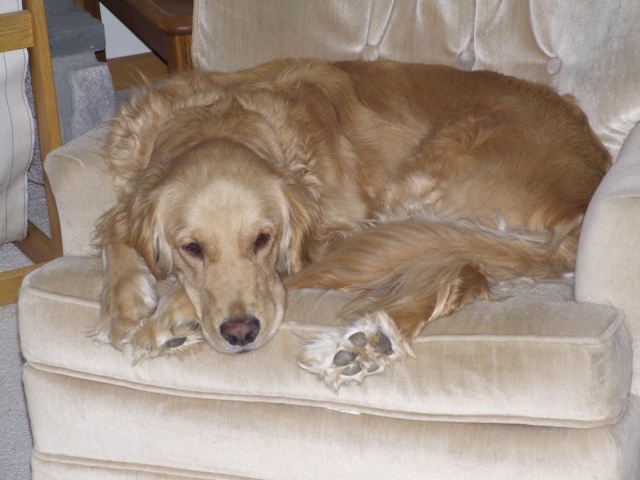QuestionI have an almost 2 year old Great Dane rescue. We have eliminated all "problems" except one. Let me give you background: He gets walked twice a day, for a total of 1 to two hours, morning before breakfast, and evening before dinner. He and the other Great Dane we have go to the dog park usually about twice a week. His problem is this: When I walk him, and we pass runners/walkers (just sometimes), he wants to go to them; sometimes I think he wants to play, sometimes I think he thinks they're a threat or suspicious and doesn't know quite what to do. At any rate, most of them carry sticks, golf clubs, or something to protect themselves with and some carry them behind their back, etc. I can understand him being supicious or wanting to play (akin to a teenager) but I can'tseem to make him understand that the behavior is unwanted in the first place. His reaction is one of jumping upwards, and trying to get away to follow that person. I really like Cesar Milan's methods, as they have helped enormously with their training. He has been through three levels of obedience training. Otherwise he is obedient on the walk, walks right next to me, and follows all commands. Some things I have tried to get him to ignore the other runners/walkers: Making him sit if I see them coming, giving a sharp tug upwards and the command "No", Making him "down" if I see them, walking past and telling him "No" repeatedly (this is how we usually go past them, but with the jumping and pulling, he is NOT heeling appropriately of course. He will see and fixate(sometimes) on them long before I see them usually. He weights about 127 and is not done growing. I can control him at present, but he could get pushy if this is not addressed I think. We have had him less than a year, and already he has made enormous progress. I make him submit directly afterwards, to change his state of mind back to submissive. Then he's fine, like nothing happened. Also, there is one runner that he always reacts to. I don't get why. The list of things I've tried is the major things; I have tried many other things such as distractions (food or otherwise) which havent worked either. We do walk the dogs together,pack style, and usually he and I are in the front, with my husband and the other Great Dane (female) in the back. I hope I have given you enough info to help! Thanks so much! Jen
Answeryour response to his behavior is most likely worsening it. By "correcting" him you are communicating fear. It's going right down the leash. You need to eliminate ALL NEGATIVE enforcers of any sort in all this dog's training. I suggest you throw out the Milan "method" and go to karen Pryor's website and learn about how to TEACH a dog, rather than coerce it. Clicker training works and it develops trust and enables the dog to think for itself and make choices that please its owners.
As to this particular problem, have someone else with you and go out somewhere to set the dog up. When a runner approaches, hand the leash to the other person and YOU turn your back and walk several steps away. The other person does nothing, says nothing, just restrains the dog calmy so it cannot chase the runner. Have the other person observe yur dog. If he looks FOR YOU, seems confused at your absence, and if he refers to YOU at least once during his attempt to "chase" the runner, then YOU are part of the problem. He is taking his cue from your adrenaline (he can smell it on your breath from many feet away.) If this is the case, then we need to take you out of the equation in much the same manner as explained above. Three times in one week, take a friend with you and each time a runner approaches and the dog goes forward, YOU turn your back and walk away from the dog. Walk further away each time. There will come a point when your dog WILL BEGIN to watch you WALK AWAY when the runner is approaching. At this point, call him to you and have your friend walk him to you on leash. Repeat this at least three times that day and then again a few days later to be sure the new behavior is set. THEN you can go out alone with your dog and, when runners approach, turn in the other direction with a "come along" (NO COLLAR SNAPS) and a pat on the head when he follows you. Show no interest in the runners. You might want to pop a tic tac in your mouth at each encounter, since your own anxiety will be apparent on your breath. DO NOT "flood" the dog with multiple runners at a time; rather, encounter them as you would on a regular walk. With this method, your dog will soon learn to walk calmly away from runners for a verbal reward and a pat on the head (piece of cheese doesn't hurt either.)
If the dog's prey drve is also involved, some further steps might need to be taken. Please advise AFTER doing the above protocol.

 uncontrollable beagle
Question
max
My beagle is a year and a half. Ive had hi
uncontrollable beagle
Question
max
My beagle is a year and a half. Ive had hi
 anxious dog
Question
Louie
Hi, We adopted a 2 year old male A
anxious dog
Question
Louie
Hi, We adopted a 2 year old male A
 Sudden aggression within pack after a death
Question
Sudden aggression in o
We have an approximatel
Sudden aggression within pack after a death
Question
Sudden aggression in o
We have an approximatel
 licking the floor not stop
QuestionGeorgie
QUESTION: Hi,
I have a 7 year ol
licking the floor not stop
QuestionGeorgie
QUESTION: Hi,
I have a 7 year ol
 aggression in aging dog
Question
Niko
I have a thirteen year old, female, Samoy
aggression in aging dog
Question
Niko
I have a thirteen year old, female, Samoy